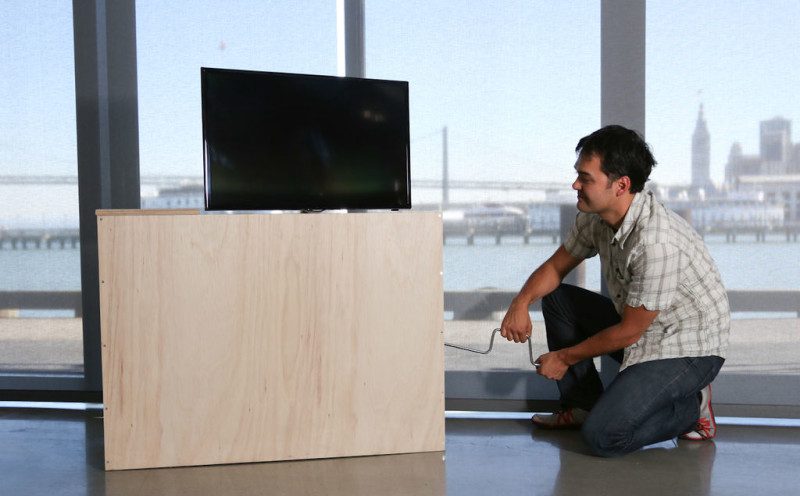How to Build Your Own Automated TV Lift
For those who would like to build a home automated TV without the need for having new media furniture, here is a way on how you can build a custom TV lift within some minutes and some modest experience. In this demonstration, the owner of the room had a TV sitting on a wooden cabinet and was rather addicted to the view of his room rather than his TV. The idea of building a pop up TV cabinet came in an effort to conceal the TV without a need to replace the furniture that is in the room. This is why we came up with the idea of the TV on the lift on this page. The distance between the room and the cabinet should be left at eight inches including the 4.5 inches of the lift mechanism as well as the 0.5 inches of the clearance room.

Figure 1: Customizing your TV lift (Source: http://www.instructables.com/id/Hand-Crank-TV-Lift/)
If the TV size or the installation location falls outside the expected parameters, then there are some adjustments that need to be made. With the new do-it-yourself kit of consumer electronics, building a custom TV lift (see more TV lifts on the page) just has become as easy as possible.
This machine is beneficial for an array of material conveyance and is available in a number of weight capacities and stroke lengths. The better ones come with limit switches or what is generally known as a built-in-end stops. The availability of this machine makes it all the easier for one to install a lift TV cabinet. In choosing the actuator, one needs to pay attention to an actuator which is more than fifty percent in weight as compared with the TV.

Figure 2: A secure linear actuator for TV lift. (Source: https://www.youtube.com/watch?v=-DBmbtBd6bg)
The second step involved selecting a switch which is rated for 12v. in this case a stealthier installation was selected. It is, however, advisable for one to determine the maximum amp of the machine to ensure personal as well as property safety.

Figure 3: Fixing actuator in position (Source: http://www.diynetwork.com/how-to/skills-and-know-how/carpentry-and-woodworking/how-to-build-a-custom-tv-lift)
Ideally, the actuator should be positioned behind the TV. All studs in the locality of the actuator should be deactivated to avoid problems. In case the exterior of the wall or the depth of the enclosure or the wall allows, the actuator should be installed on the wall to prevent the displacement of the installation. In this installation a piece of a plywood was used to mount the plate between the bracket of the actuator and the TV. With the help of a big piece of a cardboard, a template was then created to cover the reality of the TV screw holes. In other settings the template can also be extended to the bottom of the TV. Here, the cabinet acts to conceal the wall whenever the TV is down. The mounting plate of the TV was then removed and a little standing is then made for a finish. The paint was blended with the wall or the TV. Great care was however taken to ensure that the lift of the TV does not interfere with cables and or cables. In similar circumstances, this simple installation can be completed in one day depending on the needs of a person.
